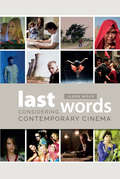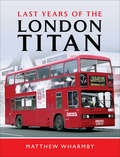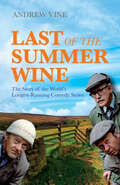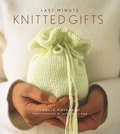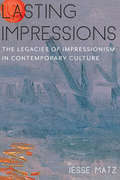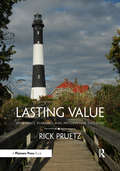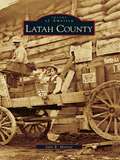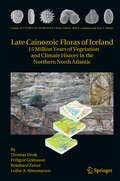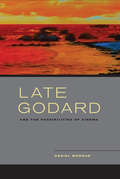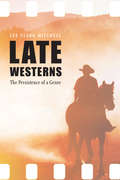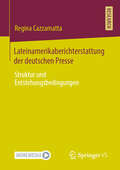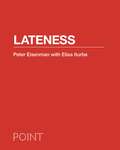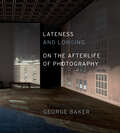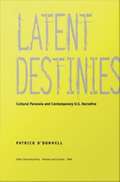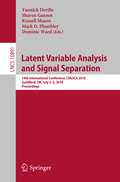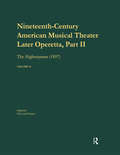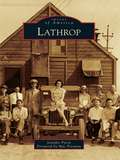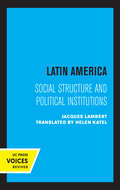- Table View
- List View
Last Words: Considering Contemporary Cinema
by Jason WoodLast Words features extensive interviews with Christopher Nolan, Harmony Korine, Charlie Kaufmann, Nicolas Winding Refn, Wim Wenders, Michael Winterbottom, Christian Petzhold, and many others. Each interview is preceded by an overview of the director's work, and the volume's authoritative introductory essay explores the value of these directors and why they are rarely given an appropriate platform to discuss their craft.
Last Years of the London Titan
by Matthew WharmbyThe author of The London Bendy Bus memorializes the end of the Leyland Titan era in &“a must for all London bus fans of the 1980s&” (West Somerset Railway Association). Already depleted by withdrawals in the London Buses Ltd era, the Leyland Titan fleet of T class was divided upon privatization between three new companies: London Central, Stagecoach East London and Stagecoach Selkent. Together with a host of smaller companies operating secondhand acquisitions, the Titans&’ declining years between 1998 and 2003 are explored in this pictorial account that encompasses both standard day-to-day routes, emergency deployments and rail replacement services. Only small numbers remained to usher out the type altogether at the end of 2005, when step-entrance double-deckers as a whole were banished from the capital. &“[A] magnificent portrait of the time through an interesting collection of images.&” —Miniaturas JM
Last of the Summer Wine: The Story of the World's Longest-Running Comedy Series
by Andrew VineAn insider’s look at story behind the longest running situation comedy in British television history.Quite simply, Last of the Summer Wine is the longest-running comedy programme in the world. It premiered thirty-seven years ago, in 1973, and, after thirty-one series it finally came to an end—even though all its original protagonists—Compo, Foggy, even Nora Batty—are now dead.Remarkably, for a series of such longevity and international appeal, it is all about elderly people, has little action or plot, and is set and filmed in and around the small Yorkshire town of Holmfirth.Now, Andrew Vine, the deputy editor of Yorkshire’s daily newspaper, has written the definitive history of this television phenomenon. It covers the show’s inauspicious beginnings, with low ratings, its endless reinvention as participants like Bill Owen, Michael Bates, Brian Wilde and Kathy Staff retired or died, the appearance of a string of guest stars from John Cleese and Norman Wisdom to Thora Hird and Russ Abbott (both of whom soon found themselves fixtures in the cast), and the ingenious plot contrivances as the protagonists became too old and frail to attempt any of the slapstick stunts with runaway prams—indeed any outdoor action.The town of Holmfirth is now a year-round tourist attraction, and the endless availability of the show via streaming, ensures that Last of the Summer Wine, and the book it inspired, will live on for generations of fans.
Last-Minute Knitted Gifts (Last Minute Gifts Ser.)
by Joelle Hoverson&“Lovely gifts in luscious yarns . . . that will never go out of style&” that can be completed in about 10 hours or—way—less (Planet Purl). Today's knitters are chic, smart-and busy. Although they love to knit and enjoy making gifts for family and friends, they're constantly faced with the challenge of finding enough time to actually finish what they've started. Last-Minute Knitted Gifts solves this problem. Joelle Hoverson, owner of Purl, the hip knitting supply store in downtown Manhattan, has designed more than 30 fun, fresh, beautiful patterns, most of which can be made in less than ten hours—some in as little as two! Known for her keen sense of color, Hoverson includes instructions for classic gifts like baby booties and bonnets, sweaters, and scarves, plus imaginative options like a cashmere tea cozy, a felted yoga mat bag, floor cushions, and a poncho—surely something for everyone on the gift list. And to make each present extra-special, Hoverson offers easy tips on how to incorporate knitting and other yarn embellishments into the gift wrap.
Lasting Impressions: The Legacies of Impressionism in Contemporary Culture (Literature Now)
by Jesse MatzImpressionism captured the world's imagination in the late nineteenth century and remains with us today. Portraying the dynamic effects of modernity, impressionist artists revolutionized the arts and the wider culture. Impressionism transformed the very pattern of reality, introducing new ways to look at and think about the world and our experience of it. Its legacy has been felt in many major contributions to popular and high culture, from cubism and early cinema to the works of Zadie Smith and W. G. Sebald, from advertisements for Pepsi to the observations of Oliver Sacks and Malcolm Gladwell. Yet impressionism's persistence has also been a problem, a matter of inauthenticity, superficiality, and complicity in what is merely "impressionistic" about culture today. Jesse Matz considers these two legacies—the positive and the negative—to explain impressionism's true contemporary significance. As Lasting Impressions moves through contemporary literature, painting, and popular culture, Matz explains how the perceptual role, cultural effects, and social implications of impressionism continue to generate meaning and foster new forms of creativity, understanding, and public engagement.
Lasting Value: Open Space Planning and Preservation Successes
by Rick PruetzAmericans are committing 'country-cide', says Rick Pruetz, FAICP, converting farms into suburban yards and channeling streams that once provided flood control, water purification, habitats, and recreational opportunities. But rather than rail against overdevelopment, this book celebrates communities succeeding in preservation. For ten years Pruetz explored communities that excel in saving their natural environment. In twenty-four illustrated vignettes, he captures the character of places from the volcanic range near downtown Albuquerque, New Mexico, to Minneapolis’s Grand Rounds park system, to farmland improbably preserved on Long Island. As the longtime city planner of Burbank, California, Pruetz offers more than an appreciation of these communities. He brings a planner’s-eye view of the practices behind their achievements. His detailed reports of creative preservation solutions mark the trail for planners, commissioners, and citizens who seek to preserve the green legacy in their own backyards.
Laszlo Moholy-Nagy: Biographical Writings
by Louis KaplanMarking the centenary of the birth of Laszlo Moholy-Nagy (1895-1946), this book offers a new approach to the Bauhaus artist and theorist's multifaceted life and work--an approach that redefines the very idea of biographical writing. In Laszlo Moholy-Nagy, Louis Kaplan applies the Derridean deconstructivist model of the "signature effect" to an intellectual biography of a Constructivist artist. Inhabiting the borderline between life and work, the book demonstrates how the signature inscribed by "Moholy" operates in a double space, interweaving signified object and signifying matter, autobiography and auto-graphy. Through interpretative readings of over twenty key artistic and photographic works, Kaplan graphically illustrates Moholy's signature effect in action. He shows how this effect plays itself out in the complex of relations between artistic originality and plagiarism, between authorial identity and anonymity, as well as in the problematic status of the work of art in the age of technical reproduction. In this way, the book reveals how Moholy's artistic practice anticipates many of the issues of postmodernist debate and thus has particular relevance today. Consequently, Kaplan clarifies the relationship between avant-garde Constructivism and contemporary deconstruction. This new and innovative configuration of biography catalyzed by the life writing of Moholy-Nagy will be of critical interest to artists and writers, literary theorists, and art historians.
Latah County (Images of America)
by Julie R. MonroeIts name derived from the Nez Perce language, Latah County is the only county in the United States to have been created by an Act of Congress. The abundance of its natural resources--from blue fields of camas to deep veins of gold, from great stands of white pine trees to vast green grasslands--attracted a diversity of dreamers seeking only the opportunity to build their own futures. Nestled in the heart of the Palouse, an agricultural area of extraordinary production, Latah County is a land of timber and, at Potlatch, was once the site of one of the largest sawmills in the world. At Moscow, it is also the home of the state's land-grant institution, the University of Idaho. From the forests of Troy and the ridges of Juliaetta and Kendrick, from the homesteads of Genesee to Bovill's hunting lodge and Deary's town site, Latah County has had a rich and varied history.
Late Antique Portraits and Early Christian Icons: The Power of the Painted Gaze (Routledge Research in Art and Religion)
by Andrew PatersonThis book focuses on the earliest surviving Christian icons, dated to the sixth and seventh centuries, which bear many resemblances to three other well-established genres of ‘sacred portrait’ also produced during late antiquity, namely Roman imperial portraiture, Graeco-Egyptian funerary portraiture and panel paintings depicting non-Christian deities. Andrew Paterson addresses two fundamental questions about devotional portraiture – both Christian and non-Christian – in the late antique period. Firstly, how did artists visualise and construct these images of divine or sanctified figures? And secondly, how did their intended viewers look at, respond to, and even interact with these images? Paterson argues that a key factor of many of these portrait images is the emphasis given to the depicted gaze, which invites an intensified form of personal encounter with the portrait’s subject. The book will be of interest to scholars working in art history, theology, religion and classical studies.
Late Antique Portraits and Early Christian Icons: The Power of the Painted Gaze (Routledge Research in Art and Religion)
by Andrew PatersonThis book focuses on the earliest surviving Christian icons, dated to the sixth and seventh centuries, which bear many resemblances to three other well-established genres of ‘sacred portrait’ also produced during late antiquity, namely Roman imperial portraiture, Graeco-Egyptian funerary portraiture and panel paintings depicting non-Christian deities.Andrew Paterson addresses two fundamental questions about devotional portraiture – both Christian and non-Christian – in the late antique period. Firstly, how did artists visualise and construct these images of divine or sanctified figures? And secondly, how did their intended viewers look at, respond to, and even interact with these images? Paterson argues that a key factor of many of these portrait images is the emphasis given to the depicted gaze, which invites an intensified form of personal encounter with the portrait’s subject.The book will be of interest to scholars working in art history, theology, religion and classical studies.
Late Cainozoic Floras of Iceland
by Friðgeir Grimsson Leifur A. Símonarson Reinhard Zetter Thomas DenkBeing the only place in the northern North Atlantic yielding late Cainozoic terrestrial sediments rich in plant fossils, Iceland provides a unique archive for vegetation and climate development in this region. This book includes the complete plant fossil record from Iceland spanning the past 15 million years. Eleven sedimentary rock formations containing over 320 plant taxa are described. For each flora, palaeoecology and floristic affinities within the Northern Hemisphere are established. The exceptional fossil record allows a deeper understanding of the role of the "North Atlantic Land Bridge" for intercontinental plant migration and of the Gulf Stream-North Atlantic Current system for regional climatic evolution. 'Iceland sits as a "fossil trap" on one of the most interesting biogeographic exchange routes on the planet - the North Atlantic. The fossil floras of Iceland document both local vegetational response to global climate change, and more importantly, help to document the nature of biotic migration across the North Atlantic in the last 15 million years. In this state-of-the-art volume, the authors place sequential floras in their paleogeographic, paleoclimatic and geologic context, and extract a detailed history of biotic response to the dynamics of physical change.' Bruce H. Tiffney, University of California, Santa Barbara 'This beautifully-illustrated monograph of the macro- and microfloras from the late Cenozoic of Iceland is a worthy successor to Oswald Heer's "Flora fossilis arctica". Its broad scope makes it a must for all scientists interested in climatic change and palaeobiogeography in the North Atlantic region. It will remain a classic for years to come.' David K. Ferguson, University of Vienna
Late Godard and the Possibilities of Cinema
by Daniel MorganWith Late Godard and the Possibilities of Cinema, Daniel Morgan makes a significant contribution to scholarship on Jean-Luc Godard, especially his films and videos since the late 1980s, some of the most notoriously difficult works in contemporary cinema. Through detailed analyses of extended sequences, technical innovations, and formal experiments, Morgan provides an original interpretation of a series of several internally related films--Soigne ta droite (Keep Your Right Up, 1987), Nouvelle vague (New Wave, 1990), and Allemagne 90 neuf zéro (Germany 90 Nine Zero, 1991)--and the monumental late video work, Histoire(s) du cinéma (1988-1998). Taking up a range of topics, including the role of nature and natural beauty, the relation between history and cinema, and the interactions between film and video, the book provides a distinctive account of the cinematic and intellectual ambitions of Godard's late work. At the same time, Late Godard and the Possibilities of Cinema provides a new direction for the fields of film and philosophy by drawing on the idealist and romantic tradition of philosophical aesthetics, which rarely finds an articulation within film studies. In using the tradition of aesthetics to illuminate Godard's late films and videos, Morgan shows that these works transform the basic terms and categories of aesthetics in and for the cinema.
Late Star Trek: The Final Frontier in the Franchise Era (Mass Markets: Storyworlds Across Media)
by Adam KotskoHow Star Trek&’s twenty-first-century reinventions illuminate the unique challenges and opportunities of franchise-style corporate storytellingLate Star Trek explores the beloved science fiction franchise&’s repeated attempts to reinvent itself after the end of its 1990s golden age. Beginning with the prequel series Enterprise, Adam Kotsko analyzes the wealth of content set within Star Trek&’s sprawling continuity—including authorized books, the three &“Kelvin Timeline&” films, and the streaming series Discovery, Picard, Lower Decks, Prodigy, and Strange New Worlds—along with fan discourse, to reflect on the perils and promise of the franchise as a unique form of storytelling. Significantly including the licensed novels and comic books that fill out the Star Trek universe for its fans, Kotsko brings the multiple productions of the early twenty-first century together as a unified whole rather than analyzing them in their current stratified view. He argues that the variety of styles and approaches in this tumultuous era of Star Trek history provides the perfect opportunity to reflect on the nature of the franchise storyworlds that now dominate popular culture. By taking the spin-offs and tie-ins seriously as creative attempts to tell a new story within an established universe, Late Star Trek highlights creative triumphs as well as the tendency for franchise faithfulness to get in the way of creating engaging characters and ideas. Arguing forcefully against the prevailing consensus that franchises are a sign of cultural decay, Kotsko contends that the Star Trek universe exemplifies an approach to storytelling that has been perennial across cultures. Instead, he finds that what limits creativity within franchises is not their reliance on the familiar but their status as modern myths, held not as common cultural heritage but rather owned as corporate intellectual property. Retail e-book files for this title are screen-reader friendly with images accompanied by short alt text and/or extended descriptions.
Late Victorian Architectural Plans and Details (Dover Architecture)
by William T. Comstock Daniel D. ReiffThis authentic reproduction of plans drawn up by a noted nineteenth-century architectural firm features both residential and public buildings. Hundreds of illustrations include floor plans, perspective views, and elevations as well as designs for staircases, fireplaces, and other interior details. Other drawings depict windows, doors, balconies, and gables. Photographs offer crisp views of exteriors. Victorian architecture buffs will prize this excellent source of authentic period designs. Its 126 plates comprise 87 images of residences; the remaining 39 structures include a field club building, stables, a library, a school, a railroad station, a dry goods store, and a music hall. Captions describe locations, dimensions, costs, and other particulars.
Late Westerns: The Persistence of a Genre (Postwestern Horizons)
by Lee Clark MitchellFor more than a century the cinematic Western has been America’s most familiar genre, always teetering on the verge of exhaustion and yet regularly revived in new forms. Why does this outmoded vehicle—with the most narrowly based historical setting of any popular genre—maintain its appeal? In Late Westerns Lee Clark Mitchell takes a position against those critics looking to attach “post” to the all-too-familiar genre. For though the frontier disappeared long ago, though men on horseback have become commonplace, and though films of all sorts have always, necessarily, defied generic patterns, the Western continues to enthrall audiences. It does so by engaging narrative expectations stamped on our collective consciousness so firmly as to integrate materials that might not seem obviously “Western” at all. Through plot cues, narrative reminders, and even cinematic frameworks, recent films shape interpretive understanding by triggering a long-standing familiarity audiences have with the genre. Mitchell’s critical analysis reveals how these films engage a thematic and cinematic border-crossing in which their formal innovations and odd plots succeed deconstructively, encouraging by allusion, implication, and citation the evocation of generic meaning from ingredients that otherwise might be interpreted quite differently. Applying genre theory with close cinematic readings, Mitchell posits that the Western has essentially been “post” all along.
Lateinamerikaberichterstattung der deutschen Presse: Struktur und Entstehungsbedingungen
by Regina CazzamattaDas vorliegende Buch zu Struktur und Entstehungsbedingung Lateinamerikas in der deutschen Presse basiert auf einer in dieser Dimension bis heute nicht vorhandenen empirischen Grundlage. Die Studie basiert auf 21.929 Beiträgen, von denen mithilfe einer geschichteten Stichprobe 4.164 in die Analyse einbezogen, ausgewertet und mit Korrespondenten-Interviews kombiniert wurden. Sie beleuchtet die Auswahlkriterien und Mechanismen der Berichterstattung zu Lateinamerika und füllte eine Forschungslücke zu einem Thema, das außenpolitisch extrem relevant ist. Das Buch betrachtet Themen und Merkmale des Mediendiskurses in kombinierter Form, stellt Länderprofile dar und sucht nach theoretischen Erklärungen für die Bildkonstruktionen. Die Studie kommt zum Ergebnis, dass es das Lateinamerikabild in der deutschen Presse nicht gibt, sondern sich eine Perzeption nach Ländern und Landesgruppen ausdifferenziert lässt. Die Forschungsarbeit ist über das Fachgebiet Medien- und Kommunikationswissenschaft hinaus interessant und bedeutet einen Gewinn für die Lateinamerikaforschung in Deutschland.
Lateness (POINT: Essays on Architecture #2)
by Peter Eisenman Elisa IturbeA provocative case for historical ambiguity in architecture by one of the field's leading theoristsConceptions of modernity in architecture are often expressed in the idea of the zeitgeist, or "spirit of the age," an attitude toward architectural form that is embedded in a belief in progressive time. Lateness explores how architecture can work against these linear currents in startling and compelling ways. In this incisive book, internationally renowned architect Peter Eisenman, with Elisa Iturbe, proposes a different perspective on form and time in architecture, one that circumvents the temporal constraints on style that require it to be "of the times"—lateness. He focuses on three twentieth-century architects who exhibited the qualities of lateness in their designs: Adolf Loos, Aldo Rossi, and John Hejduk. Drawing on the critical theory of Theodor Adorno and his study of Beethoven's final works, Eisenman shows how the architecture of these canonical figures was temporally out of sync with conventions and expectations, and how lateness can serve as a form of release from the restraints of the moment.Bringing together architecture, music, and philosophy, and drawing on illuminating examples from the Renaissance and Baroque periods, Lateness demonstrates how today's architecture can use the concept of lateness to break free of stylistic limitations, expand architecture's critical capacity, and provide a new mode of analysis.
Lateness and Longing: On the Afterlife of Photography (Abakanowicz Arts and Culture Collection)
by George BakerHow a generation of women artists is transforming photography with analogue techniques. Beginning in the 1990s, a series of major artists imagined the expansion of photography, intensifying its ideas and effects while abandoning many of its former medium constraints. Simultaneous with this development in contemporary art, however, photography was moving toward total digitalization. Lateness and Longing presents the first account of a generation of artists—focused on the work of Zoe Leonard, Tacita Dean, Sharon Lockhart, and Moyra Davey—who have collectively transformed the practice of photography, using analogue technologies in a dissident way and radicalizing signifiers of older models of feminist art. All these artists have resisted the transition to the digital in their work. Instead—in what amounts to a series of feminist polemics—they return to earlier, incomplete, or unrealized moments in photography’s history, gravitating toward the analogue basis of photographic mediums. Their work announces that photography has become—not obsolete—but “late,” opened up by the potentially critical forces of anachronism. Through a strategy of return—of refusing to let go—the work of these artists proposes an afterlife and survival of the photographic in contemporary art, a formal lateness wherein photography finds its way forward through resistance to the contemporary itself.
Latent Destinies: Cultural Paranoia and Contemporary U.S. Narrative
by Patrick O'DonnellLatent Destinies examines the formation of postmodern sensibilities and their relationship to varieties of paranoia that have been seen as widespread in this century. Despite the fact that the Cold War has ended and the threat of nuclear annihilation has been dramatically lessened by most estimates, the paranoia that has characterized the period has not gone away. Indeed, it is as if--as O'Donnell suggests--this paranoia has been internalized, scattered, and reiterated at a multitude of sites: Oklahoma City, Waco, Ruby Ridge, Bosnia, the White House, the United Nations, and numerous other places. O'Donnell argues that paranoia on the broadly cultural level is essentially a narrative process in which history and postmodern identity are negotiated simultaneously. The result is an erasure of historical temporality--the past and future become the all-consuming, self-aware present. To explain and exemplify this, O'Donnell looks at such books and films as Libra, JFK, The Crying of Lot 49, The Truman Show, Reservoir Dogs, Empire of the Senseless, Oswald's Tale, The Executioner's Song, Underworld, The Killer Inside Me, and Groundhog Day. Organized around the topics of nationalism, gender, criminality, and construction of history, Latent Destinies establishes cultural paranoia as consonant with our contradictory need for multiplicity and certainty, for openness and secrecy, and for mobility and historical stability. Demonstrating how imaginative works of novels and films can be used to understand the postmodern historical condition, this book will interest students and scholars of American literature and cultural studies, postmodern theory, and film studies.
Latent Variable Analysis and Signal Separation: 14th International Conference, LVA/ICA 2018, Guildford, UK, July 2–5, 2018, Proceedings (Lecture Notes in Computer Science #10891)
by Mark D. Plumbley Sharon Gannot Yannick Deville Russell Mason Dominic WardThis book constitutes the proceedings of the 14th International Conference on Latent Variable Analysis and Signal Separation, LVA/ICA 2018, held in Guildford, UK, in July 2018.The 52 full papers were carefully reviewed and selected from 62 initial submissions. As research topics the papers encompass a wide range of general mixtures of latent variables models but also theories and tools drawn from a great variety of disciplines such as structured tensor decompositions and applications; matrix and tensor factorizations; ICA methods; nonlinear mixtures; audio data and methods; signal separation evaluation campaign; deep learning and data-driven methods; advances in phase retrieval and applications; sparsity-related methods; and biomedical data and methods.
Later Byzantine Painting: Art, Agency, and Appreciation (Variorum Collected Studies)
by Robert S. NelsonWritten over nearly three decades, the fifteen essays involve the three a's of the title, art, agency, and appreciation. The first refers to the general subject matter of the book, Byzantine art, chiefly painting, of the twelfth through the fourteenth centuries, the second to its often human-like agency, and the last to its historical reception. Responding to different issues and perspectives that have animated art history and Byzantine studies in recent decades, the essays have wide theoretical range from art historical formalism, iconography, archaeology and its manuscript equivalent codicology, to statistics, patronage, narratology, and the histories of science and collecting. The series begins with art works themselves and with the imagery and iconography of church decoration and manuscript illumination, shifts to the ways that objects act in the world and affect their beholders, and concludes with more general appreciations of Byzantine art in case studies from the thirteenth century to the present.
Later Operetta 2: the Highwayman, Music by Reginald DeKoven, Libretto by Harry B. Smith, 1897 (Nineteenth-Century American Musical Theater Series)
by Reginald De KovenThe most successful American-born composer of operetta at the end of the nineteenth century was Reginald de Koven. The work reprinted in this volume, The Highwayman, is arguably his best work, although he is better known for the earlier Robin Hoodwixh its evergreen wedding ballad "Oh Promise Me." (Robin Hood is available as a reprint in the 1990 volume American Opera and Music for the Stage, in the G.K. Hall series Three Centuries of American Music.) The editor of this volume, Orly Leah Krasner, is a leading scholar of de Koven’s music. She teaches at the City University of New York, and her Ph.D. dissertation, "Reginald de Koven (1859-1920) and American Comic Opera at the Turn of the Century," is also from that university. Her introduction places the work in the tenor of contemporary critical reaction, and lists the sources available for further study. The Highwayman is one of the few complete operettas of its era for which we are fortunate enough to have original performing materials in the composer’s own hand. As the penultimate volume (number 15) in this series, de Koven’s work of 1897 contrasts with two works of the previous year, Walter Damrosch’s opera The Scarlet Letter (volume 16) and John Philip Sousa’s operetta El Capitan (volume 14).
Lathrop
by Mac Freeman Jennifer PyronFirst home to Yokut Indians, then trappers, hunters, and fishermen, Lathrop was founded by Leland Stanford in 1869 as a railroad town and an answer to Stanford's frustration with his railroad attempts in Stockton. Lathrop's rich history includes the railroad, its Delta waterways, manufacturing and distributing industries, and the fascinating tale of California Supreme Court justice David S. Terry's murder (Terry had previously fought and won the last legal duel in California with U.S. senator David C. Broderick just outside of San Francisco). Reportedly named in honor of a relative of Leland Stanford Jr., today's Lathrop evolved from rugged railroad beginnings to a growing and vibrant community of close to 20,000 residents.
Latin America: Writings on Architecture, Landscape, and the Environment, 1876-1925
by Jacques LambertThis title is part of UC Press's Voices Revived program, which commemorates University of California Press’s mission to seek out and cultivate the brightest minds and give them voice, reach, and impact. Drawing on a backlist dating to 1893, Voices Revived makes high-quality, peer-reviewed scholarship accessible once again using print-on-demand technology. This title was originally published in 1967.
